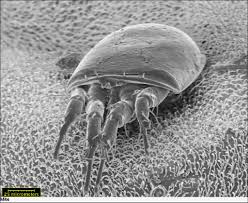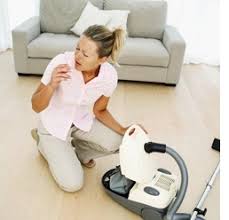DUST MITES



You might also be interested in:
House dust mites can trigger respiratory or dermatological conditions including asthma and eczema. Symptoms can include:
The characteristics of a house dust mite include:
Unlike other common household bugs (fleas, for example), dust mites don’t bite. Their bodies, secretions and faeces contain particular proteins that can trigger allergic symptoms in susceptible people.
The diet of the house dust mite includes shed skin flakes, pollen and fungal spores. It prefers warm, humid and dark environments. Common hiding spots around the home include:
Allergy testing can find out whether house dust mites trigger your respiratory or dermatological symptoms. See your doctor for further information and advice.
If tests show that you are allergic to house dust mites, there are ways to reduce your immune system response. For example, you could undergo immunotherapy, which involves deliberately exposing you to dust mite extracts to ‘train’ your immune system not to overreact. Measures designed to reduce your household’s dust mite population may also be helpful.
It is impossible to destroy your entire dust mite population, but you can dramatically reduce their numbers. Allergic reactions are dose-related, so the fewer dust mites you have in your home, the less you may be troubled by respiratory or dermatological symptoms. It is important to remember that the droppings of dead dust mites continue to provoke allergic reactions. You must not only reduce your dust mite population, but also take steps to remove their dead bodies and faeces from your home.
Strategies include:
Some treatments that claim to reduce dust mite populations have little or no benefit. Treatments that won’t help include:
Summary
The house dust mite has been associated with a range of respiratory and dermatological allergies, such as asthma and eczema. The main component of dust is shed skin flakes, which is the mite's preferred food source. Areas around the home that are heavily used, such as beds and upholstered furniture, will have higher mite populations.
You might also be interested in:
The most common type of dust mite found in Australian homes is Dermatophagoides pteronyssinus, which tends to prefer coastal rather than inland areas. This mite has been associated with dermatological and respiratory allergies in humans, such as eczema and asthma. However, there is no single, definitive sign that house dust mites trigger a person’s allergy symptoms. Asthma, for example, can be triggered by a range of other indoor allergens such as fungi (moulds) or animal dander (dander is fluff from hair, fur or feathers).
Symptoms of allergic reaction to house dust mites
House dust mites can trigger respiratory or dermatological conditions including asthma and eczema. Symptoms can include:
- Wheezing
- Coughing
- Breathlessness
- A tight feeling in the chest
- Runny nose
- Itchy nose
- Itchy eyes
- Itchy skin
- Skin rashes.
Physical characteristics of the house dust mite
The characteristics of a house dust mite include:
- Less than half a millimetre in length, which makes it hard to see with the naked eye
- Wingless
- Oval-shaped body
- Light coloured body with fine stripes
- Life span of around two months or so, depending on the conditions.
The allergic reaction
Unlike other common household bugs (fleas, for example), dust mites don’t bite. Their bodies, secretions and faeces contain particular proteins that can trigger allergic symptoms in susceptible people.
Common hiding spots
The diet of the house dust mite includes shed skin flakes, pollen and fungal spores. It prefers warm, humid and dark environments. Common hiding spots around the home include:
- Mattresses and bed linen
- Upholstered furniture
- Shag-pile or long-fibred carpets
- Soft toys.
Diagnosis and treatment for dust mite allergies
Allergy testing can find out whether house dust mites trigger your respiratory or dermatological symptoms. See your doctor for further information and advice.
If tests show that you are allergic to house dust mites, there are ways to reduce your immune system response. For example, you could undergo immunotherapy, which involves deliberately exposing you to dust mite extracts to ‘train’ your immune system not to overreact. Measures designed to reduce your household’s dust mite population may also be helpful.
You need to reduce the dust mites in your home
It is impossible to destroy your entire dust mite population, but you can dramatically reduce their numbers. Allergic reactions are dose-related, so the fewer dust mites you have in your home, the less you may be troubled by respiratory or dermatological symptoms. It is important to remember that the droppings of dead dust mites continue to provoke allergic reactions. You must not only reduce your dust mite population, but also take steps to remove their dead bodies and faeces from your home.
Tips to reduce house dust mites in your home
Strategies include:
- Cover mattress, pillow and quilt with dust mite resistant covers. The covers must be washed every two months. Some health funds may provide a rebate for these items.
- Wash sheets and pillowcases weekly in water hotter than 55°C. Alternatively, if washing in cold water, use a commercial product containing essential oils, like eucalyptus or tea tree oil.
- Hot tumble dry (for half an hour after dry) or dry clean household items – this will kill house dust mites, but not the allergen they produce.
- Wash blankets and non-encased doonas every two months.
- Use synthetic rather than feather pillows and doonas, as these tolerate regular washing.
- Remove sheepskin or woollen underlays and any other sheepskin products.
- Remove all soft toys from the bedroom and replace with wooden or plastic toys, which can be washed. Or, if a soft toy is allowed, it should be washed weekly using the same method used for sheets. (Freezing soft toys overnight does not work, because it doesn’t remove allergen).
- Damp dust or use electrostatic cloths to clean hard surfaces weekly, rather than a feather duster.
- Reduce humidity – have a dry and well-ventilated house. Have adequate floor and wall insulation and avoid evaporative coolers.
- Avoid upholstered furniture – leather, vinyl, plastic and wood are best.
- Windows – Venetian blinds or flat blinds are better than heavy curtains. Washable curtains or external shutters are other options.
- Wash clothing before use if it has been stored for a long time
- Wash rugs and mats regularly and dry them outside in full sunshine (if possible).
- Vacuum weekly, including the seams of mattresses and upholstered furniture. Vacuuming causes house dust mite allergens to become airborne for up to 20 minutes, so if you are allergic to dust mites, you should wear a mask or ask someone else to vacuum. You may air the house for an hour or so after vacuum cleaning to help clear the air.
Dubious house remedies
Some treatments that claim to reduce dust mite populations have little or no benefit. Treatments that won’t help include:
- Chemical sprays
- Air filters
- Electric blankets
- Negative ion generators
- Allergen-free products.
Where to get help
- Your doctor
- Asthma Victoria Tel. 1800 645 130
Things to remember
- The house dust mite gets its name from its habitat – household dust.
- The house dust mite has been associated with a range of respiratory and dermatological allergies.
- If you are allergic to house dust mites, it may help to reduce their population, and remove their dead bodies and faeces from your home as much as possible.
- You may also need to consider dealing with other allergens in your home to which you may be sensitive. For example, pet owners may need to keep their pets out of doors.
No comments:
Post a Comment